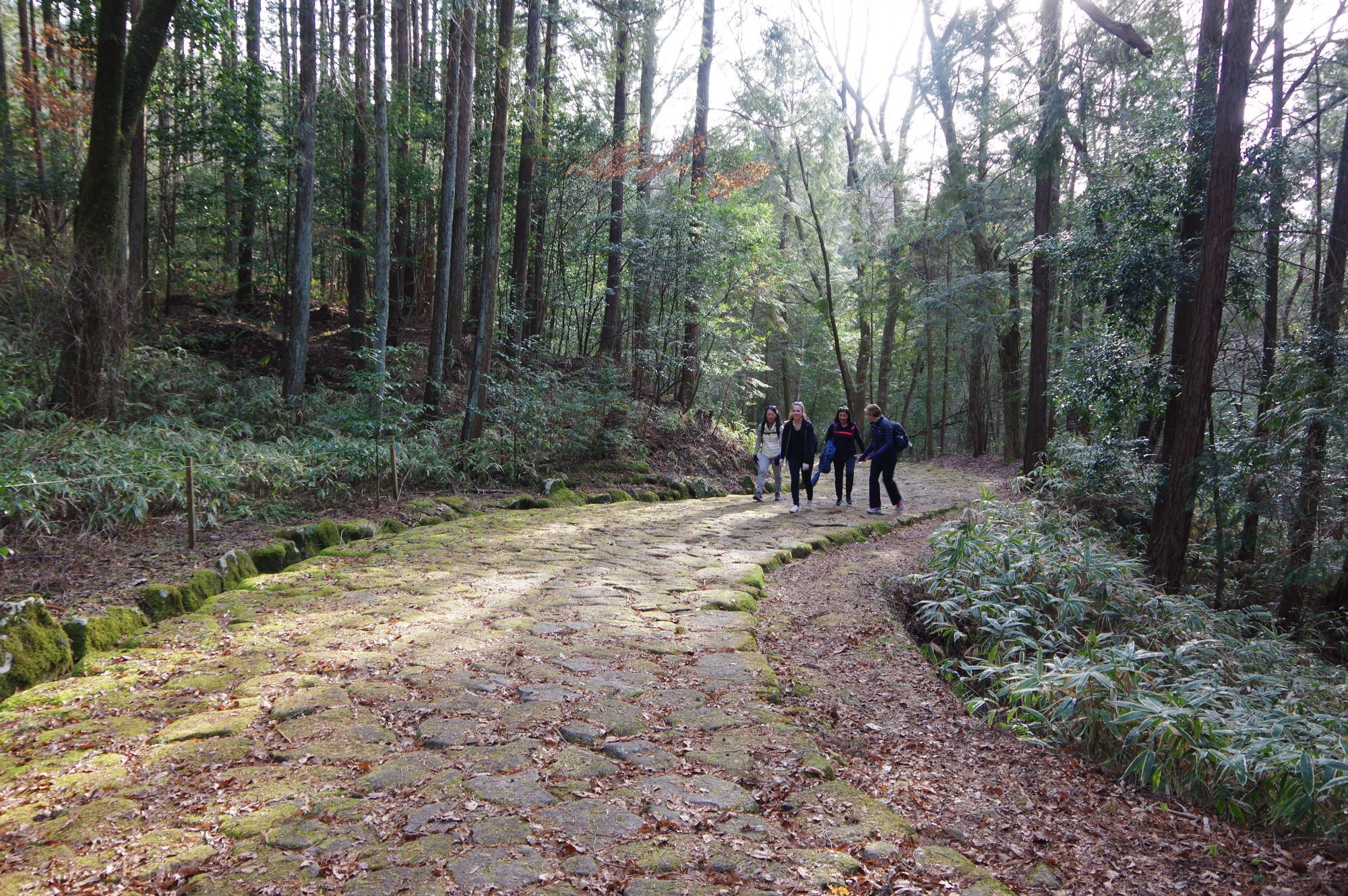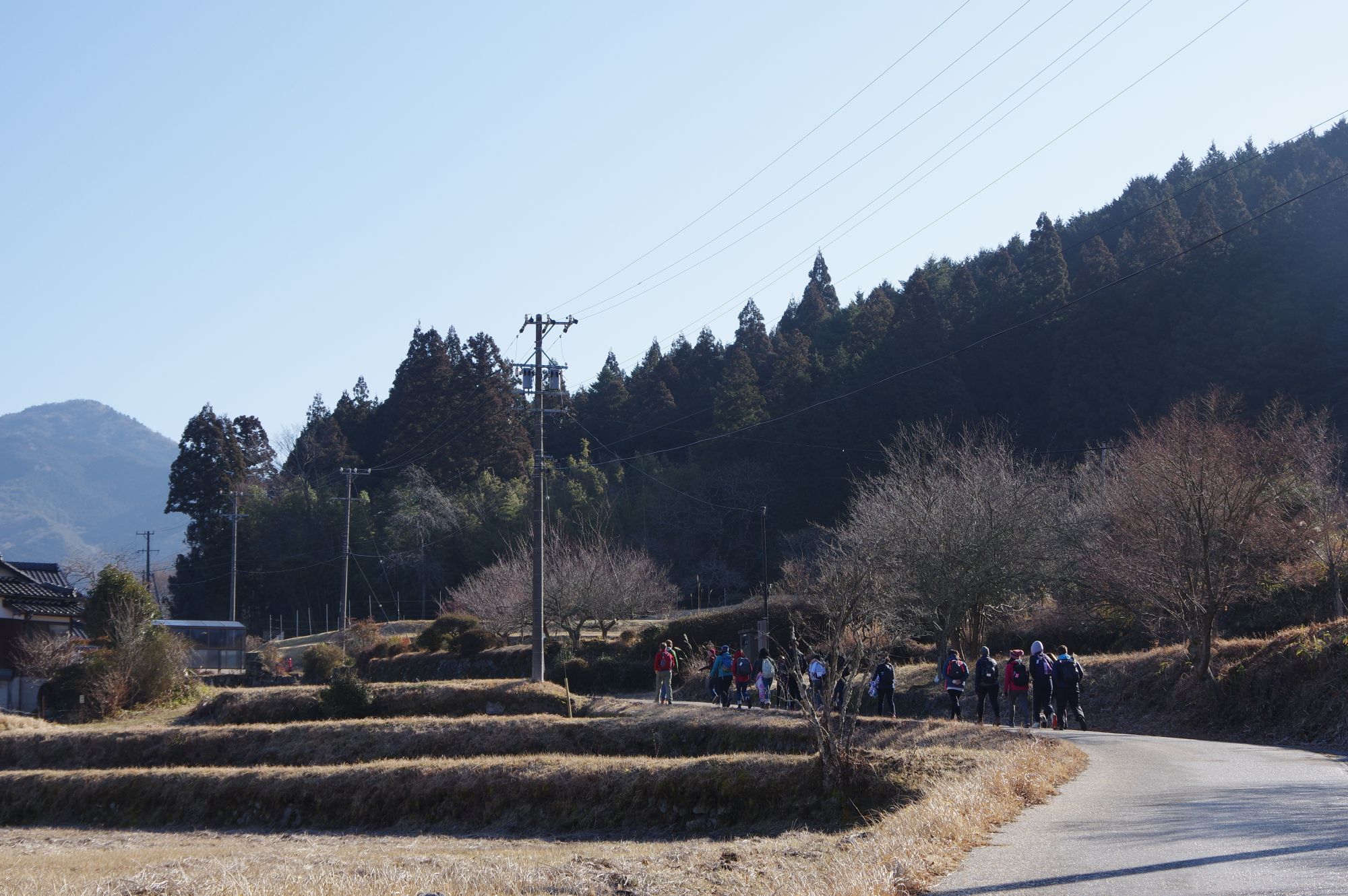A 10 day, 9 night tour starting in Kyoto and finishing in Tokyo. Walk Japan adapts its trips for group size and age and welcomes groups of any size and students of any age. Currently, for our school trips the groups vary in size from 8 to 60 students and in age from 12 years to post-graduate university students.
This trip takes us to the old capital of Kyoto, the megalopolis of Tokyo, and, very much off-the-beaten-track, to central Japan and the Nakasendo Way, an ancient highway in the beautiful Kiso Valley.
After delving into the facinating history and elegant culture found in Kyoto, we explore one of the old highways of Japan, the Nakasendo, or 'road through the central mountains'. Once a main thoroughfare of feudal Japan, today the Nakasendo provides a delightful excursion through scenic countryside.
En route we delve into Japan’s elegant culture; its history, especially when the samurai were at the height of their power; and modern life both in Japan’s cities and countryside. We stay in atmospheric, traditional inns; enjoy a wide variety of Japanese cuisine; and make friends with the Japanese, some of the politest and friendliest people on earth.
Sights include exquisite temples and gardens in historic Kyoto, the bright lights of cosmopolitan Tokyo, and quiet, pretty villages in secluded valleys. We experience the Japanese way of life including sleeping on futons, bathing in wooden baths and eating while sitting on tatami mat floors. We learn why the Nakasendo Way existed and about Tokugawa Ieyasu, the great shogun leader who established a dynasty that ruled Japan for over 260 years. We also learn to sing traditional folk songs and visit a school. Of course, each day also provides opportunities to learn some Japanese. Other highlights include singing karaoke and exploring Tokyo’s Harajuku, which has long been at the centre of Japanese youth culture.
Day 1 Kansai International Airport - Kyoto
Arrive late afternoon at Kansai International Airport, where the Walk Japan Tour Leader welcomes everyone to Japan. We transfer to Kyoto and our accommodation. After checking in the Tour Leader provides a full briefing on our trip together through Japan.
Accommodation: Western-style business hotel.
Meals: Dinner provided.
Total walking: N/A.
Day 2 Kyoto
After breakfast, we venture out into Kyoto. An elegant city, Kyoto was Japan’s capital from 794 until 1869, when Edo, the shogun’s citadel, was renamed Tokyo and became the capital. Although no longer at the centre of power, Kyoto does, however, remain firmly at the centre of much of the nation’s traditional culture. It is home to 17 UNESCO World Heritage Sites and our exploration of the city begins at one of these, Nijo-jo castle. Nijo-jo was the Kyoto residence of the Tokugawa Shoguns, who ruled Japan throughout the Edo Period from 1603 until 1868. We explore the magnificent audience halls and private quarters, the only examples still in existence, and learn about daily life at the shogun’s court.
From earthly power we transfer across town to heavenly power and the UNESCO sites of Rokuon-ji and Ryoan-ji temples. Rokuon-ji is famed for its stunning Golden Pavilion, a three-storied traditional wooden structure coated in gold leaf. Reflected in a lake set in beautiful gardens, the Pavilion is one of Japan’s most recognisable icons. Next we visit nearby Ryoan-ji, where we find the epitome of a Zen Buddhist rock garden; a subtle and meditative space that contrast dramatically with the extravagance we witnessed earlier at Rokuon-ji.
Later, we experience the Japanese tea ceremony in the informative and enthralling company of a master of the art. Under his guidance we delve into the ceremony, a delightful and deeply meaningful practice far from the rigid image it often has, and also make tea for each other. Appreciation of art and ceramics is as much a part of our time here as making and drinking the tea itself.
Accommodation: Western-style business hotel.
Meals: Breakfast, lunch and dinner provided.
Total walking: N/A.
Day 3 Kyoto
We begin the day at Sanjusangen-do, where 1001 statues of Kannon, the goddess of mercy, are aligned in serried ranks in one of the longest wooden halls in Japan. From here we stroll through the streets of Kyoto to Kiyomizu-dera, a temple that juts spectacularly out from a hillside. We stroll on, this time on a lesser beaten forested path up to the ridge of hills that border the eastern side of the city before arriving at Chion-in, a temple housing a 70 ton bell. The largest in Japan, a 17 strong team is required to ring it.
Our walk continues on into the bustling centre of town, where we visit Nishiki market, where the ingredients that go into Kyoto’s distinct cuisine are on display, and neighbouring Teramachi, a covered street lined with a wide variety of shops.
Accommodation: Western-style business hotel.
Meals: Breakfast, lunch & dinner provided.
Total walking: 7 km (4.3 miles).
Day 4 Kyoto - Nagoya - Nakatsugawa - Yamaguchi
After breakfast, we transfer by Shinakansen bullet train and local trains to Nakatsugawa. Located at the southern end of the Kiso Valley, this pleasant rural town marks the start of our journey along the Nakasendo Way. Once a vital transport artery, today it is a mostly overlooked but very pleasant trail through the Japanese countryside. We walk through charming rural scenery to Shinchaya, a traditional inn and our accommodation for the night.
Upon arriving, we first learn the vital do’s and don’ts of living in the traditional Japanese style; Where do we take off our shoes? Where are the beds, or rather futons? How do we use the baths? Etc. Clad in the distinctive and popular yukata gowns we gather for dinner, a feast of rural cuisine.
Accommodation: Japanese inn.
Meals: Breakfast, lunch & dinner provided.
Total walking: 6km (3.7 miles).
Day 5 Yamaguchi - Magome - O-Tsumago
A short walk through idyllic countryside brings us to Magome, a post-town that was the home to Shimazaki Toson. Toson was Japan's first modern novelist and author of Before the Dawn, which relates the upheaval to local society wrought by the end of samurai rule. We have time to freely explore Magome, a pleasant old town with many cafes and shops, and also purchase lunch, which we eat as a picnic further along the Nakasendo Way. Then, onwards along the old highway over a pass via quiet roads and forest paths to Otsumago, a hamlet aside a river composed of a small cluster of inns. Tonight, we stay in another traditional and very atmospheric inn. Bathing at an onsen hot spring precedes our dinner, after which we are joined by a local who sings ballads from the Kiso Valley and encourages us to join in.
Accommodation: Japanese inn.
Meals: Breakfast, lunch, & dinner provided.
Total walking: 8km (5 miles).
Day 6 O-Tsumago - Tsumago - Nagiso - Kiso-Fukushima
We continue walking along the Nakasendo Way to Tsumago, another charming post-town where we visit the waki-hojin, a high-class inn that once accommodated travellers of importance and wealth. A short walk brings us to Nagiso. Although the old town has long since disappeared through development, Momosuke Bridge makes any visit to the town worthwhile. Here we learn about Momosuke Fukuzawa, who built the bridge and developed hydro-electric power in the Kiso Valley, and also about Sadayakko, Momosuke’s partner and geisha, who became world famous at the turn of the 20th Century.
We board a train here for Kiso-Fukushima, where a local school invites us to join the students for a cultural exchange that may include engaging in games or club activities. Our modern inn has its own onsen hot spring bath for us to leisurely soak in before dinner.
Accommodation: Japanese inn.
Meals: Breakfast, lunch & dinner provided.
Total walking: 6km (3.7miles).
Day 7 Kiso-Fukushima - Tori Pass - Narai
Kiso-Fukushima was one of two sites on the Nakasendo Way with a sekisho barrier station. Built astride all the old highways by the shogunate to control traffic, sekisho were much feared institutions and the reconstructed site at Kiso-Fukushima provides us with insights into why this was so. After breakfast we explore the reconstructed barrier station, a check-point astride the Nakasendo Way. A short transfer by local train brings us to our walk up and over the beautiful Torii Pass, the third highest on the Nakasendo Way, to Narai, another picturesque post-town. Narai’s single street is lined with period buildings housing shops, restaurants, cafes and inns, including the one we stay in for the night.
Accommodation: Japanese inn.
Meals: Breakfast, lunch & dinner provided.
Total walking: 8km (5miles).
Day 8 Narai - Tokyo
After an early breakfast, we journey by train to Ryogoku in downtown Tokyo for a guided visit of the excellent Edo-Tokyo Museum. The museum describes the changing urban environment and life of its residents from the Edo Period through the end of the feudal age and Japan's early fascination with the West up to the nation's post-war economic revival. From here we visit Ameyoko-cho, a bustling downtown street market that has its origins as a flourishing black market in the ruins of Tokyo after World War 2, before moving on to Akihabara. Akihabara, which originally found fame for its many electronics shops, has in recent years also become the centre of anime and manga with many shops devoted to the genres. We enjoy our dinner here before retiring to our hotel for the night.
Accommodation: Western-style business hotel.
Meals: Breakfast, lunch and dinner provided.
Total walking: N/A.
Day 9 Tokyo
This morning, we enjoy a walking exploration of Tokyo beginning at Nihonbashi, the centre of commercial Japan in the Edo Period and the point to which all the nation’s principal roads, including the Nakasendo Way, led. Nihonbashi was literally on the door step of Edo-jo, the shogun’s citadel, and this is where most travellers to Edo completed their journeys.
We walk via the modern business district of Marunouchi to the Imperial Palace. Marunouchi is now Japan’s premier business district but was once an integral part of castle grounds and we uncover some clues to this on our way. After the demise of the samurai, Edo-jo became the Imperial Palace and today it provides a verdant refuge, some 5km (3.11 miles) in circumference, at the very centre of Tokyo. However, as large as the current extent of the Palace grounds are, they represent only a fragment of Edo Castle’s original 16 km (9.94 miles) periphery.
We transfer by Tokyo’s clean and super efficient public transport system to Harajuku, which has long been the centre of Japanese youth culture. Here clothes stores and cafes, squeezed next to each other, are frequented by fashionable young Japanese. We have free time to explore the area and also visit the adjacent, upmarket Aoyama district.
After dinner we celebrate our week long adventure together by trying our vocal skills at karaoke, a favourite pastime in Japan.
Accommodation: Western-style busines hotel.
Meals: Breakfast and dinner provided.
Total walking: N/A.
Day 10 Tokyo - Tokyo Airport
After breakfast, we depart to the airport for our flight back home.
Accommodation: N/A.
Meals: Breakfast provided.
Total walking: N/A.
This itinerary is subject to change.
More information about the history of the Nakasendo highway is available at our complementary website Nakasendo Way: A Journey to the Heart of Japan.




















